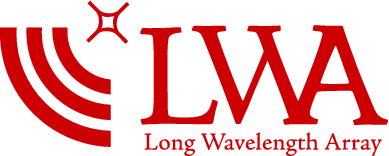


 On August 15, 2005 I joined the faculty at UNM, where we have
a strong radio group including the
Long Wavelength Array.
I am also the Director of the
Center for Astrophysical Research
and Technologies. For more details, here is my vita.
On August 15, 2005 I joined the faculty at UNM, where we have
a strong radio group including the
Long Wavelength Array.
I am also the Director of the
Center for Astrophysical Research
and Technologies. For more details, here is my vita.
We have an active radio astronomy group within PandA. Faculty members Jayce Dowell and Greg Taylor are contributing to the Long Wavelength Array effort. Adjunct faculty Ken Obenberger (AFRL), Frank Schinzel (NRAO), and Stephen White (SNL), are also involved. Students interested in radio astronomy and/or the LWA are encouraged to contact one of us.
We are also active in studies of the ionosphere, space weather, and meteors using low frequencies. Much of this work is done in collaboration with adjunct faculty Ken Obenberger (AFRL) and Stephen White (AFRL), and with other researchers at AFRL. Students interested in these research activities are encouraged to contact one of us.
 LWA System Engineer Joe Craig works with a team of student volunteers to
build an LWA stand. The first 38 antennas of the first LWA station were installed on Oct 18, 2009.
LWA System Engineer Joe Craig works with a team of student volunteers to
build an LWA stand. The first 38 antennas of the first LWA station were installed on Oct 18, 2009.
GLAST has launched successfully and is performing beautifully. We anticipate that many of our favorite blazars imaged in VIPS and elsewhere will be detected by GLAST. We have put together a web page describing Radio Observations of Active Galaxies planned during the GLAST mission.
I've been chasing after the radio afterglows from Gamma-Ray Bursts, especially GRB 030329, with both the VLA and VLBA.
We have now finished a couple large VLBI surveys of Active Galactic Nuclei. Here is a link to those 300+ maps in the PR and CJ surveys and the visibility data. My summer 2002 student, Lindsey Pollack, has analyzed polarimetry from 182 sources in CJF. I continue to do a lot of followup observations with the VLA, OVRO mma, Palomar, Keck, and VLBA telescopes.
I'm also continuing to study radio galaxy environments, mostly through the use of Faraday rotation measure observations with the VLA and VLBA. Surprisingly large RMs are found in typical quasars. These results are reported in Evidence for ordered magnetic fields in the quasar environment, Magnetic Fields in Quasar Cores and Magnetic Fields in Quasar Cores II. My former Ph.D. student Bob Zavala has recently completed the study of a larger sample of Radio Galaxies, Quasars, and BL Lacs.
Along with Martin Shepherd and Tim Pearson we have developed automatic mapping for Difmap. We're using the latest FITS version of Difmap and you should be too. Here is the link to the latest release. I recommend mapplot for making images and overlays.
I could go on and on but you might be getting sleepy. Take a look at my publications if you want to know more about what I've been doing.

Last Modified on 2023 July 7
Greg Taylor Phone: (505) 270-2929
Phone: (505) 270-2929